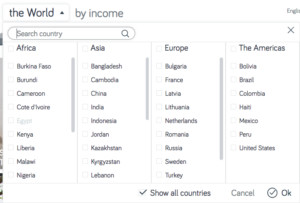Integrating social studies and literature offers a powerful avenue to cultivate a global perspective in students. For many, the world beyond their immediate surroundings remains abstract. Concepts like different countries and cultures can feel distant and difficult to relate to. This is where tools like Dollar Street become invaluable, bridging geographical divides and fostering genuine understanding.
One of the core objectives in global education is to empower students to grasp diverse viewpoints. This skill extends far beyond the classroom, enriching their ability to understand fictional characters in literature, leading to enhanced reading comprehension and critical thinking. By learning to see the world through another’s eyes, students can appreciate both the unique differences and the universal similarities that shape human experiences across various environments. These explorations nurture acceptance and a deeper understanding of diverse populations. Crucially, recognizing these differences also anchors students in their own identities and belief systems. Once students begin to identify differences, the next step is to guide them towards recognizing the common threads that connect us all – the similarities that far outweigh our disparities.
A remarkable online resource dedicated to combating global ignorance is Gapminder. “Ignorance,” in this context, simply refers to a lack of knowledge. Many prejudices and stereotypes stem from this very lack of information. Gapminder tackles outdated notions and preconceived biases head-on by providing factual, accessible data that anyone can understand. Their mission is to enlighten and broaden perspectives through reliable information.
 life span
life span
Gapminder’s website is truly exceptional. Its visually engaging charts and graphs offer countless opportunities for insightful discussions as you and your students delve into data interpretation. Even if numbers aren’t your forte, the site presents information in an approachable way, often posing questions that are then answered by the data, such as how does income correlate with life expectancy? Each data set is accompanied by a concise video explanation (under 2 minutes), a slideshow to aid chart interpretation, and the option to download high-resolution posters – all designed to make complex information digestible and engaging. But the best part is yet to come.
One of the most compelling tools within Gapminder, and the focus of our exploration today, is Dollar Street. Dollar Street provides a visual journey into everyday life around the world, organizing photographs based on families’ income levels. Dollar Street’s core message is powerful: “We all share fundamental needs, but our financial means to meet them vary. Everyday life appears surprisingly similar for individuals at comparable income levels across diverse cultures and continents.” This is a profound insight and an exceptional starting point for cultivating a global perspective, even among the youngest learners.
Begin your Dollar Street exploration by selecting a topic of interest:
 topics
topics
The topics are grounded in everyday realities, making it easy to draw immediate connections to your students’ own lives. Consider having students bring in photos from home related to the chosen topic – perhaps their pet, their bed, or a favorite toy. Start by comparing these familiar images within your classroom, initiating a discussion about similarities and differences in their immediate context. You could even incorporate a brief writing assignment centered around these personal items.
Expand this exploration globally by selecting a specific country or region you wish to explore within Dollar Street:
 country
country
Dollar Street also allows you to refine your visual search by adjusting the income range displayed, using the sliders at the top of the page. This feature enables you to focus on specific economic strata and compare living conditions across different income brackets globally.
The search results are presented as a series of photographs, each identifying the country of origin and the family’s income:
 results
results
These visual results are springboards for rich classroom conversations. Encourage students to observe both similarities and differences in the photographs. As mentioned in the original article, even a four-year-old can notice familiar elements, like a universally recognized character such as Lightning McQueen, highlighting common cultural touchstones. You can integrate geography lessons by locating the countries featured on a map. For deeper engagement, select a particular image and click on it to “meet” the family featured. This personalizes the learning experience, transforming a “bed in Ukraine” into the bed of a real family with names and stories. This humanizing element fosters empathy and deeper connections.
Integrating Dollar Street Across Curriculum
Social Studies Integration:
- Data-Driven Discussions: Analyze human and physical characteristics of different places and discuss their interplay and mutual influence.
- Geography: Enhance geographical literacy by locating countries and regions on maps, contextualizing the Dollar Street visuals.
- Economics: Use the images as starting points for exploring different countries’ economies and income disparities.
- Perspective Taking: Examine stereotypes and prejudices, using Dollar Street as a factual counterpoint to challenge preconceived notions and promote informed perspectives.
English/Language Arts Integration:
- Personal Connections: Encourage students to create personal connections by adding their own images related to Dollar Street topics, fostering a sense of participation and self-reflection.
- Comparative Writing: Prompt students to write comparative pieces analyzing their own situations in relation to what they observe in the Dollar Street photographs, enhancing analytical and writing skills.
Dollar Street offers a dynamic and visually engaging platform for educators to broaden students’ horizons, fostering a deeper understanding of global interconnectedness and challenging them to see the world, and each other, in new and meaningful ways.

